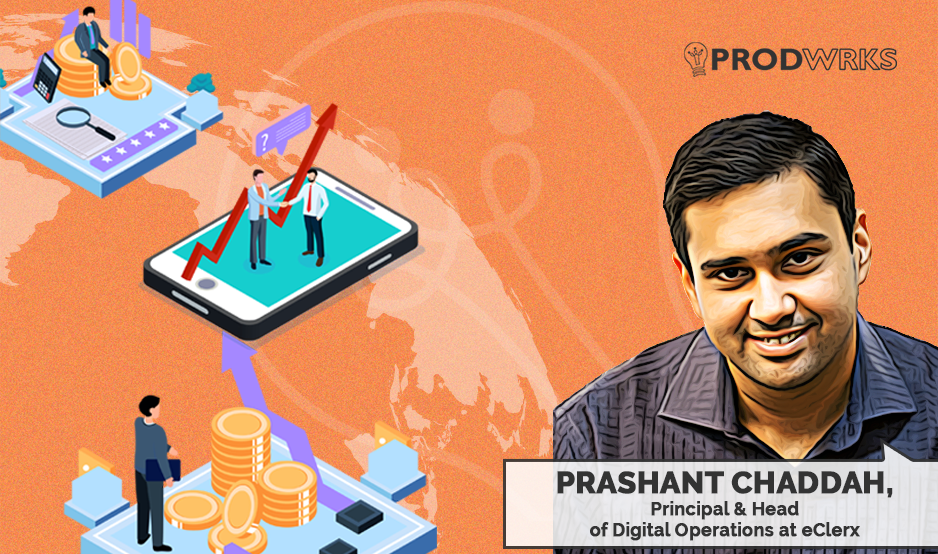
The author of this article is Prashant Chaddah, Principal & Head of Digital Operations at eClerx
As India reasserts its economic might and underscores its ambitions of becoming a developed nation by 2047, capital markets in the country are attracting hordes of investors and outperforming global peers in terms of retail investor participation. More than 100 million new demat accounts have been opened between March 2020 and March 2024; attributed in no small part to the ever-improving access to capital markets that is being brought upon due to the unbridled pace of digital technological innovation.
As a result, more than 50% of the daily market transactions are now contributed by retail investors, more than double of what is seen in more developed economies like the USA. With retail investors become a dominating force across Indian capital markets, especially for asset classes like equities, mutual funds and their like, digital transformation is slated to introduce a new trading paradigm and transform the retail investor experience like never before.
Let us look at some factors which have helped achieve some of these staggering numbers:
1. Financial literacy
Financial literacy has significantly improved, particularly enhancing investment access in tier 2 and tier 3 cities.
This progress has been driven by increased access to reports and analyses, resulting in heightened user awareness.
Noteworthy statistics include:
- Ownership of shares among the population has risen from 7% to 20% since 2019, accompanied by a notable increase in small monthly investments in mutual funds (source: Economist, 2024).
- Technological innovations such as the India Stack digital infrastructure, Aadhaar digital ID, and Unified Payments Interface (UPI) have revolutionized the accessibility of financial services, particularly benefiting the unbanked population.
- Between 2013 and 2017, the percentage of individuals above 15 years old in India with accounts at banks, financial institutions, or mobile money service providers surged from 35% to 81%, underscoring the rapid expansion of financial inclusion facilitated by digital transformation (source: Carnegie Endowment, 2024).
2. Enhanced Customer Experience:
The customer experience has seen significant advancements in recent years. Fintech companies utilize analytics to offer personalized recommendations tailored to individual risk profiles and goals. Banks have streamlined services by integrating credit, investment, and savings accounts into unified digital platforms, enabling seamless account opening without requiring in-person visits.
This convenience extends to mobile devices, empowering users to manage investments and trade stocks from the comfort of their homes, thereby enhancing overall trading volume and activity.
- Example 1: IDFC FIRST Bank has introduced fully digital account opening procedures using eKYC, video KYC, and OTP-based authentication. This allows customers to onboard remotely without paperwork or visiting a branch, ensuring a rapid, convenient, and contactless account opening experience.
- Example 2: Paytm Money employs data analytics and machine learning to deliver personalized investment advice. By analyzing user risk profiles, investment objectives, and historical behaviors, the platform recommends suitable mutual funds, stocks, and other financial products, enhancing the precision and relevance of financial recommendations for its users.
3. Gamification in Financial Education:
Gamification has proven effective in both educating people about finance and encouraging investment. It provides visual progress tracking towards financial goals and offers incentives such as Paytm cash or rewards for completing transactions. Leaderboards are also used to stimulate transactional activity.
- Example 1: CRED, a prominent Indian fintech app, integrates extensive gamification features. Its “Spin the Wheel” daily engagement strategy offers users 10 chances to win rewards such as bitcoins and gift vouchers, enhancing user interaction and incentivizing financial behaviors.
- Example 2: Paytm Money, a platform for investment and wealth management under Paytm, employs gamification through interactive quizzes, challenges, and rewards. These features are designed to make financial education engaging and accessible for retail investors, fostering a deeper understanding of investment principles.
- Example 3: Groww, a popular investment app, utilizes gamification techniques such as virtual stock trading games. These simulations provide users with a risk-free environment to learn about investing, allowing them to practice before committing real money. This approach enhances user confidence and competence in financial decision-making.
Things to watch out for:
1. Regulatory Compliance in Financial Services:
Regulatory expectations emphasize the need for robust IT infrastructures to support seamless integration across multiple systems and platforms. Downtime resulting from technological gaps has drawn scrutiny from Indian regulators, leading to instances where banks were restricted from issuing new cards.
The Reserve Bank of India (RBI) has highlighted concerns over recurrent technology failures in certain banks, prompting supervisory actions to bolster IT frameworks and mitigate future incidents. Additionally, lapses in Know Your Customer (KYC) procedures by Indian fintech companies have resulted in regulatory repercussions.
To address these issues, the RBI has introduced new guidelines mandating banks to conduct periodic KYC updates for customers, varying from every 2 to 10 years based on individual risk profiles. These measures aim to enhance regulatory compliance and strengthen customer protection in the financial sector.
2. Awareness of Dark Patterns in Financial Practices:
It is crucial to remain vigilant against dark patterns, which are deceptive tactics used by platforms or fintech companies to manipulate consumers into making investments that primarily benefit the platform itself.
For instance, advertisements on platforms like Facebook promoting stock purchases or sales may not always have the consumer’s best interests in mind.
It is advisable for individuals to exercise caution and thoroughly read terms and conditions (TnCs), despite the common tendency to overlook them in today’s digital age, where attention spans are often limited. Dark patterns require continuous education to combat effectively, ensuring consumer protection and ethical practices in financial transactions
3. Combating Money Laundering and Terrorist Financing:
The advent of digital financial options has eliminated traditional boundaries, enabling financial transactions without geographic constraints. In response, banks are mandated to maintain vigilant oversight over customer transactions to detect any suspicious activities promptly.
Any flagged transactions must be reported to the Financial Intelligence Unit (FIU-IND) for further investigation. Analytics plays a pivotal role in this surveillance effort, as malicious actors may attempt to launder illegally obtained funds through multiple transactions within the financial system.
This risk isn’t confined to local jurisdictions; globally, individuals can exploit the rapidity of online transactions to evade restrictions and compliance measures on fintech platforms. Efforts to combat these challenges necessitate robust monitoring frameworks and international cooperation to uphold financial integrity and prevent illicit financial activities.
Digital Transformation in Capital Markets
As the pace of digital transformation gains further pace, firms innovating with new digital processes and solutions that address key customer, market and regulatory challenges will benefit immensely in the foreseeable future.
Simultaneously, existing players will have to up their ante to stay relevant, boding well for the industry at large and retail investors in particular. With India progressing well towards its ambition of becoming a $10trillion economy by 2032, digital transformation will simplify access to the country’s capital markets even further, helping millions of new investors in partaking in the ensuing wealth creation journey.
About the Author




